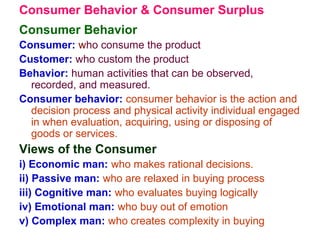
5. consumer surplus
- 1. Consumer Behavior & Consumer Surplus Consumer Behavior Consumer: who consume the product Customer: who custom the product Behavior: human activities that can be observed, recorded, and measured. Consumer behavior: consumer behavior is the action and decision process and physical activity individual engaged in when evaluation, acquiring, using or disposing of goods or services. Views of the Consumer i) Economic man: who makes rational decisions. ii) Passive man: who are relaxed in buying process iii) Cognitive man: who evaluates buying logically iv) Emotional man: who buy out of emotion v) Complex man: who creates complexity in buying
- 2. Characteristics of Consumer Behavior a) Learned behavior: repetition, work, habit, tanning b) Motivational behavior: S – O – R c) Mental process: complex mental process d) Internal factors: perception, attitude, personality e) External factors: culture, beliefs, values, norms f) Different roles: same person plays different roles g) Varied behavior: differ from one person to another h) Maintain sequence: focus most important fact first i) Consumer surplus: mental price> actual price j) Consumer deficit: mental price< actual price k) Business Process: involved transaction and exchange l) Combination: of various activities, planning to decision m) Black box: it acts as a black box.
- 3. Factors Affecting Consumer Behavior 1) Cultural Factors: cultural factor exert a broad and deep influence on consumer behavior. The marketer needs to understand the role played by the buyer’s culture, sub culture, social class. 2) Social Factors: a consumer's behavior also is influenced by social factors, such as the consumer's small groups, family and social roles and status. 3) Personal Factors: a buyer's decisions also are influenced by personal characteristics such as the buyer's age and life cycle stage, occupation, economic situation, lifestyle, and personality and self-concept. 4) Psychological Factors: buying choices are further influenced by four major psychological factors; motivation, perception, learning, beliefs, attitudes.
- 4. Consumer Satisfaction Customer satisfaction: is a function of perceived performance & expectation of customer about a product. 1. Perceived Performance: is the difference between Total customer value and Total customer costs. i) Total customer value: i) product value ii) service value iii) personal value iv) image value. ii) Total customer costs: i) monetary cost ii) time cost iii) energy cost iv) psychic cost. 2. Expectation of Customer: customer expect from the existing product; it depends on the following factors i) past experiences ii) friends iii) associates iv) competitors v) marketing activities. Measuring Customer Satisfaction i) complaint & suggestion systems ii) customer satisfaction surveys iii) ghost shopping iv) lost customer analysis v) sales and profit analysis.
- 5. Consumer Surplus Consumer surplus is the difference between the potential price and the actual price of a customer. N. mango MU MP (tk.) CS • 01 50 25 25 • 02 40 25 15 • 03 30 25 05 • 04 25 25 00 • Total 145 100 45 ------------------------------------------------------------------------- • 05 20 25 -- 05 Consumer surplus = 45 Consumer deficit: opposite of consumer surplus. Consumer deficit = -- 05
- 6. D Di Y R M D 0 A B C X P S N Quantity Price Y P 0 N R B M T S Q MR X Consumer’s Equilibrium CS A C
- 7. Criticism of Consumer Surplus i) Marginal money is unchanged: but it is fluctuated ii) It depends on demand schedule: but it is difficult iii) Taste and income is equal: different from man to man iv) No substitute: but this not realistic v) No complementary product: it is exist in the market v) It is not applicable: for emergency and luxury product vi) Difficult to calculate: it is complex mental process vii) Economic point: of view it is hypothetical & unrealistic Practical Applications of Consumer Surplus: i) Difference between exchange value and use value: price is exchange and potential is use value. ii) Comparative study: use of tk.500 in Bangladesh & Italy iii) Monopoly business: high price & no consumer surplus
- 8. Practical Applications of Consumer Surplus: iv) For international trade: satisfaction between foreign and domestic product. v) Tax fixation: avoid the taxes where surplus is absence vi) Cost &benefit: use it in cost and benefit analysis. Consumer’s Equilibrium: consider only one product i) Want and income: wants are unlimited and income is limited. How to satisfy the want with the limited income. ii) Satisfaction: when he distribute his limited income for buying different product and gets highest satisfaction, then he reach the level of equilibrium. iii) Marginal utility: purchase quantity depends on his marginal utility and when marginal utility is zero (0), he does not buy more units.
- 9. Producers Surplus Producer’s surplus is defined as the amount that producers are paid for a product less than the total variable cost of producing the product. Total revenue – Total variable cost = producer’s surplus. In the figure, SS is the supply and variable cost curve and variable cost is OQES. PPi is the market price. OQEP is the total revenue. Producer’s Surplus is OQEP – OQES = SEP Deadweight Loss: the terms refers to the loss of economic welfare arising from distortions in prices and output such as those due to monopoly, tariffs or quotas. The net loss of economic welfare is called deadweight loss. In the figure, E is the efficient point level of production at which MC = AC; at the price level100, the output is 6 units. But monopoly reduce output below E; at the price level150, the output is 3 units.
- 10. Y 0 X OQEP – OQES = SEP Producers surplus Y 150 0 X CS Deadweight loss . . . . . . . . . P S D Si E Q D 100 AC=MC MR 3 6 D E D Monopoly and Loss B
